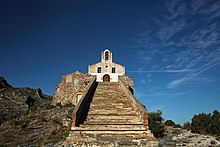Cases-de-Pène
| Cases-de-Pène | ||
|---|---|---|

|
|
|
| region | Occitania | |
| Department | Pyrénées-Orientales | |
| Arrondissement | Perpignan | |
| Canton | La Vallée de l'Agly | |
| Community association | Perpignan Méditerranée Métropole | |
| Coordinates | 42 ° 47 ' N , 2 ° 47' E | |
| height | 36-362 m | |
| surface | 13.38 km 2 | |
| Residents | 926 (January 1, 2017) | |
| Population density | 69 inhabitants / km 2 | |
| Post Code | 66600 | |
| INSEE code | 66041 | |
| Website | Cases-de-Pène | |
 Cases-de-Pène |
||
Cases-de-Pène is a town in the south of France and a municipality with 926 inhabitants (as of January 1, 2017) in the Pyrénées-Orientales department in the Occitania region in the historic province of Roussillon .
Location and climate
Cases-de-Pène is located on the Agly River on the south-eastern edge of the Corbières massif, about 16 km (driving distance) northwest of Perpignan at an altitude of almost 100 m . The climate is temperate to warm; Rain (approx. 610 mm / year) falls mainly in the winter half-year.
Population development
| year | 1800 | 1851 | 1901 | 1954 | 1999 | 2016 | ||
| Residents | 140 | 325 | 518 | 432 | 430 | 920 | ||
| Source: Cassini and INSEE | ||||||||
The significant increase in population at the beginning of the 21st century is essentially due to the proximity to the greater Perpignan area.
economy
The place and its surrounding area are still largely agriculturally oriented, although the need and the will for self-sufficiency after the improvement of the infrastructure in the second half of the 20th century no longer exist today. The place has turned into a wine place; the wines produced here may be marketed under various appellations .
history
Although the prehistoric site of Tautavel is only a few kilometers away, the researchers assume that there was no continuous settlement of the region until Roman times. In the hinterland of the Mediterranean coast, which is only a few kilometers away, has led from about 120 BC Along the expanded and fortified Via Domitia , which connected Italy and southern Gaul with the colonies on the Iberian Peninsula . However, the Romans, Visigoths and even the Moors hardly left any traces. The Carolingians conquered the region in the 9th century and built the so-called " Spanish Mark " as a bulwark against the Moors. From this time or a little later, the existence of a castle (Castellum de Pena) is documented for Cases .
In the Middle Ages there was enormous activity of the orders and monasteries in the region, but their focus was a little further south. From 1276 to 1344 the region belonged to the Kingdom of Mallorca . The late 14th and 15th and 16th centuries were troubled times that only ended with the Peace of the Pyrenees (1659). All previously built fortresses (including the city wall of Cases) were razed. Mainly because of the newly introduced taxes, the French central power was not popular and so there were several smaller popular uprisings.
Attractions
- The small parish church of Saint-Pantaléon with its bell tower of bricks dates back to the 17th century.
- Surroundings
- The Ermitage Notre-Dame-de-Pène , built in the 16th century on the site of the former castle, is located on a 335 m high cliff about 2 km southwest of the village . The last section of the climb is a long straight staircase. The chapel is recognized as a monument historique .
- The Tour del Far rises on a 508 m high hill on the north-western border to the neighboring municipality of Tautavel , which probably functioned primarily as a watchtower and not - as the name suggests - as a lighthouse.
- The ruinous little church of Sainte-Colombe once belonged to the neighboring village of Cavanac , which has since disappeared ; it is mentioned as early as the 11th century.
Web links
- Cases-de-Pène - Photos + Info (French)

